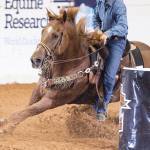Common Musculoskeletal Problems of Barrel-Racing Horses

Bursts of speed and sharp turns, accelerations and decelerations, agility and athleticism characterize winning barrel-racing runs. In the fiercest of competition, a thousandth of a second may separate the winning go from the runner-up run and with it thousands of dollars in prize money. Barrel-racing horses sustain musculoskeletal injuries, just as eventers, jumpers, and harness-racing horses do, but are some injuries more common than others?
Researchers reviewed the medical records of 118 barrel-racing horses, all of which turned out to be Quarter Horses. The horses enrolled in the study were presented by their owners for either lameness (61%) or poor performance (39%). While the most common performance change was a refusal to deftly turn the first barrel, other complaints included a decrease in speed, a wide turn around the third barrel, reluctance to enter the arena, or refusal to not turn in one direction.*
The forelimbs were the site of most lamenesses, with the right forelimb more affected (48%) than the left (43%). In 31 of the horses, both forelimbs were affected. Left hind limb lameness was affected in 31% of horses, while right hind limb lameness in 21%. In 6 horses, both hind limbs were affected.
The five most common musculoskeletal problems of barrel horses in this study were:
- Foot pain (39 horses; all forelimb);
- Osteoarthritis of lower hock joints (17 horses);
- Suspensory ligament injury (15 horses; 6 forelimb, 9 hind limb);
- Foot pain and osteoarthritis of lower hock joints (11 horses); and
- Bruised feet (10 horses; 9 forelimb, 2 hind limb).
As mentioned previously, an oft-told complaint of barrel racers is refusal of the horse to turn sharply around the first barrel. Barrel racers often start the cloverleaf pattern by executing the right barrel first. This pattern dictates that a short burst of speed is followed by 360○ turn in a clockwise direction, whereby the horse places much stress on the right forelimb. Horses may be refusing to turn this barrel because they are trying to avoid potential pain associated with right forelimb lameness.
Barrel racing horses often require joint supplements to stay at the top of their game. Choose research-proven supplements formulated by reputable manufacturers.
*Dabareiner, R.M., N.D. Cohen, G.K. Carter, S. Nunn, and W. Moyer. 2005. Musculoskeletal problems associated with lameness and poor performance among horses used for barrel racing: 118 cases (2000-2003). Journal of the American Veterinary Medical Association 227(10):1646-1650.








